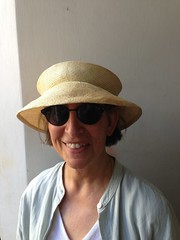
I'm a writer, publishing both as SJ Rozan and, with Carlos Dews, as Sam Cabot. (I'm Sam, he's Cabot.) Here you can find links to my almost-daily blog posts, including the Saturday haiku I've been doing for years. BUT the blog itself has moved to my website. If you go on over there you can subscribe and you'll never miss a post. (Miss a post! A scary thought!) Also, I'll be teaching a writing workshop in Italy this summer -- come join us!
Read/Post Comments (7)
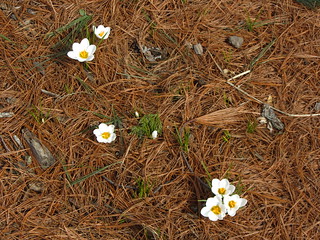
We're with the band
Mongolians love their music. Everywhere, we found singers ready to perform for us, and many Mongolian men have at least some proficiency on the horse-head fiddle (sort of the national instrument). From what I could see -- or, hear -- Mongolian musical traditions aren't wide, but they're deep. That is, they don't have huge varieties of types of music, but the types they have are well understood, well loved, and widely performed. The vans we drove in had tapes (which felt like a weirdly ancient technology) and the drivers sang along. We went to folk performances in UB, saw singers, dancers and ensembles at each of the Naadams we stopped at ("Naadam" means festival, we went to four, and more on them later) and in the ger camps (more on them later, too) the performances came to us. The students of the Cultural University in UB, training in the traditional forms, put together performing groups and take summer jobs in the tourist ger camps. They cook and clean and build the fire in your ger, and they'll do a show after dinner if you want one. Minimally, the group will be four performers who're friends from school and decided to spend the summer this way; sometimes, as many as eight or nine if the camp's big enough. They're paid for the performances by the audience, at a ticket cost of one US dollar per performer plus a dollar for the camp, the dollar being universal currency in the tourist camps. Thus a four-performer show will cost you five bucks, an eight-performer show, nine bucks, etc. Any way you look at it, unbelievably cheap to us, and the performers make money and get to practice besides.
What sort of performances are we talking about? As I said, the minimal group will be a horse-head fiddle player who, if the group is small, will also be a throat singer;
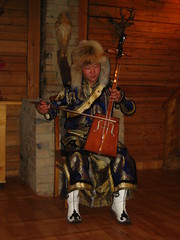
a long-song singer;
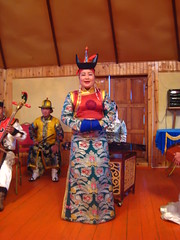
a dancer;
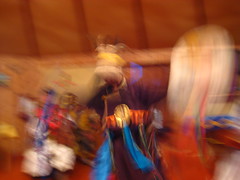
and a contortionist.
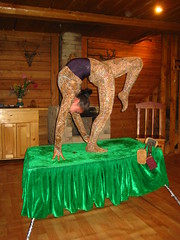
Hey, we're talking traditional arts here, gang.
In addition, if the group's big enough, there'll be a throat singer who only sings and doesn't play;
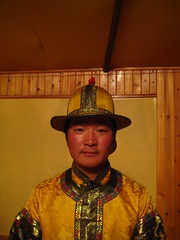
and there might be a zither player
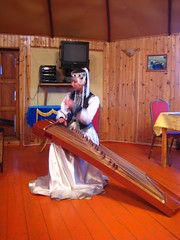
short-song singers
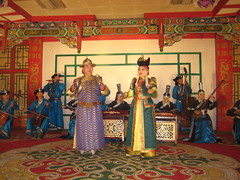
("Long song" and "short song" refer to the length of time each syllable takes to sing, not to the length of the song itself. Short songs are sung more or less normally; in long song each sound is stretched out.)
and maybe hammer dulcimer, flute or horn players.
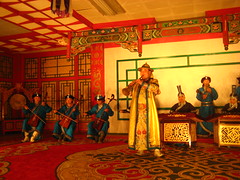

If you haven't heard throat singing, an amazing sound, try two things. One, this;
and two, rent yourself a copy of "Genghis Blues," a documentary about an American blues singer who goes to Tuva to compete in the throat singing competition.
In addition to all the folks above, sometimes you find a young performer-in-training
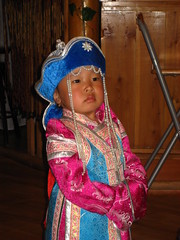
and if you're really lucky -- an accordionist!
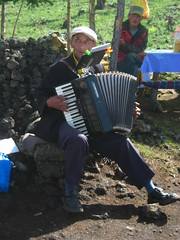
The accordion's a legacy from the Russian days. We found this guy at the head of the trail up an extinct volcano, belting out Russian songs from his youth.
We're with the band.
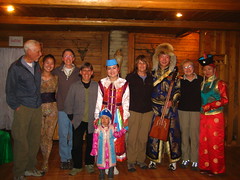
What sort of performances are we talking about? As I said, the minimal group will be a horse-head fiddle player who, if the group is small, will also be a throat singer;

a long-song singer;

a dancer;

and a contortionist.

Hey, we're talking traditional arts here, gang.
In addition, if the group's big enough, there'll be a throat singer who only sings and doesn't play;

and there might be a zither player

short-song singers

("Long song" and "short song" refer to the length of time each syllable takes to sing, not to the length of the song itself. Short songs are sung more or less normally; in long song each sound is stretched out.)
and maybe hammer dulcimer, flute or horn players.


If you haven't heard throat singing, an amazing sound, try two things. One, this;
and two, rent yourself a copy of "Genghis Blues," a documentary about an American blues singer who goes to Tuva to compete in the throat singing competition.
In addition to all the folks above, sometimes you find a young performer-in-training

and if you're really lucky -- an accordionist!

The accordion's a legacy from the Russian days. We found this guy at the head of the trail up an extinct volcano, belting out Russian songs from his youth.
We're with the band.

Read/Post Comments (7)
Previous Entry :: Next Entry
Back to Top